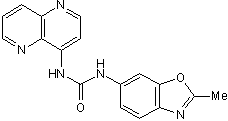
SB 334867 is a selective non-peptide orexin OX1 receptor antagonist. pKb values are 7.2 and < 5 for inhibition of intracellular Ca2+ release in CHO cells expressing human OX1 and OX2 receptors respectively. Blocks orexin-A induced grooming and feeding following systemic administration in vivo.
| Molecular Weight | 319.32 |
| Formula | C17H13N5O2 |
| CAS Number | 792173-99-0 |
| Form | Solid |
| Solubility (25°C) | DMSO 31.93 mg/mL (with gentle warming) |
| Storage |
Powder -20°C 3 years ; 4°C 2 years In solvent -80°C 6 months ; -20°C 1 month |
| Species | Mouse | Rat | Rabbit | Guinea pig | Hamster | Dog |
| Weight (kg) | 0.02 | 0.15 | 1.8 | 0.4 | 0.08 | 10 |
| Body Surface Area (m2) | 0.007 | 0.025 | 0.15 | 0.05 | 0.02 | 0.5 |
| Km factor | 3 | 6 | 12 | 8 | 5 | 20 |
| Animal A (mg/kg) = Animal B (mg/kg) multiplied by | Animal B Km |
| Animal A Km |
For example, to modify the dose of Compound A used for a mouse (20 mg/kg) to a dose based on the BSA for a rat, multiply 20 mg/kg by the Km factor for a mouse and then divide by the Km factor for a rat. This calculation results in a rat equivalent dose for Compound A of 10 mg/kg.
| Related OX Receptor Products |
|---|
| [Ala11, D-Leu15]-Orexin B(human)
[Ala11,D-Leu15]-Orexin B(human) is a potent and selective orexin-2 receptor (OX2) agonist. |
| Orexin B, rat, mouse
Orexin B, rat, mouse (Rat orexin B) is an endogenous agonist at Orexin receptor with Kis of 420 and 36 nM for OX1 and OX2, respectively. |
| Hypocretin (70-98), human
Hypocretin (70-98), human is a polypeptide that is capable of binding to an orexin receptor OX1R and promotes apoptosis. |
| Xenopus orexin A
Xenopus orexin A is a neuropeptides that identified as an endogenous ligands for an orphan G-protein-coupled receptor. |
| Xenopus orexin B
Xenopus orexin B is a neuropeptides that identified as an endogenous ligands for an orphan G-protein-coupled receptor. |


Products are for research use only. Not for human use. We do not sell to patients.
© Copyright 2010-2023 AbMole BioScience. All Rights Reserved.
